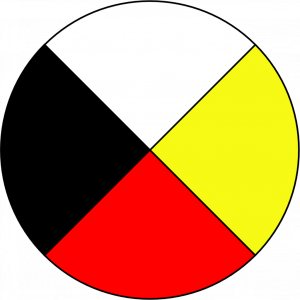The Importance of the Medicine Wheel
The Importance of the Medicine Wheel
Topic 3 – The Importance of the Medicine Wheel
The cycle of life through many dimensions can be captured and symbolized through the medicine wheel. Historically, medicine wheels may have taken the form of a stone circle with vertical and horizontal lines bisecting in the middle (Kemppainen et al., 2008). A more recent rendition involves colouring of the quadrants and the colours and quadrants may vary based on the community it represents.

At the centre is the intersection point that represents the individual balanced between these quadrants. There are many, many teachings using the medicine wheel, and some are described in the linked interactive site (below) that features versions of the Medicine Wheel teachings from five perspectives including Mikmaq, Mohawk, Ojibwe, Cree and Blackfoot. This site has audio narration, visual interactives, and transcripts as well as teaching resources and can be found at FourDirectionsTeachings.com.
Building on the value, symbolism, and importance of the circle, are the talking circles or sharing circles used in Indigenous teaching and learning environments. Circles have been used since time immemorial to demonstrate that everyone is connected and that every person in the circle has an equal voice. They also ensure that everyone can see and hear the speaker and turn-taking is also important. It is a much different model than the traditional classroom with the instructor at the front and rows upon rows of students facing forward. The power differential is much different between these two styles of environments.
References:
Kemppainen, D., Kopera-Frye, K., & Woodard, J. (2008). The medicine wheel: A versatile tool for promoting positive change in diverse contexts. Collected Essays on Learning and Teaching: The Evolving Scholarship of Teaching and Learning, 1, 80-84.
Littlejohn657 (Author). (2021). Medicine Wheel [Image]. Wikimedia Commons. https://commons.wikimedia.org/wiki/File:Medicine_Wheel.png

